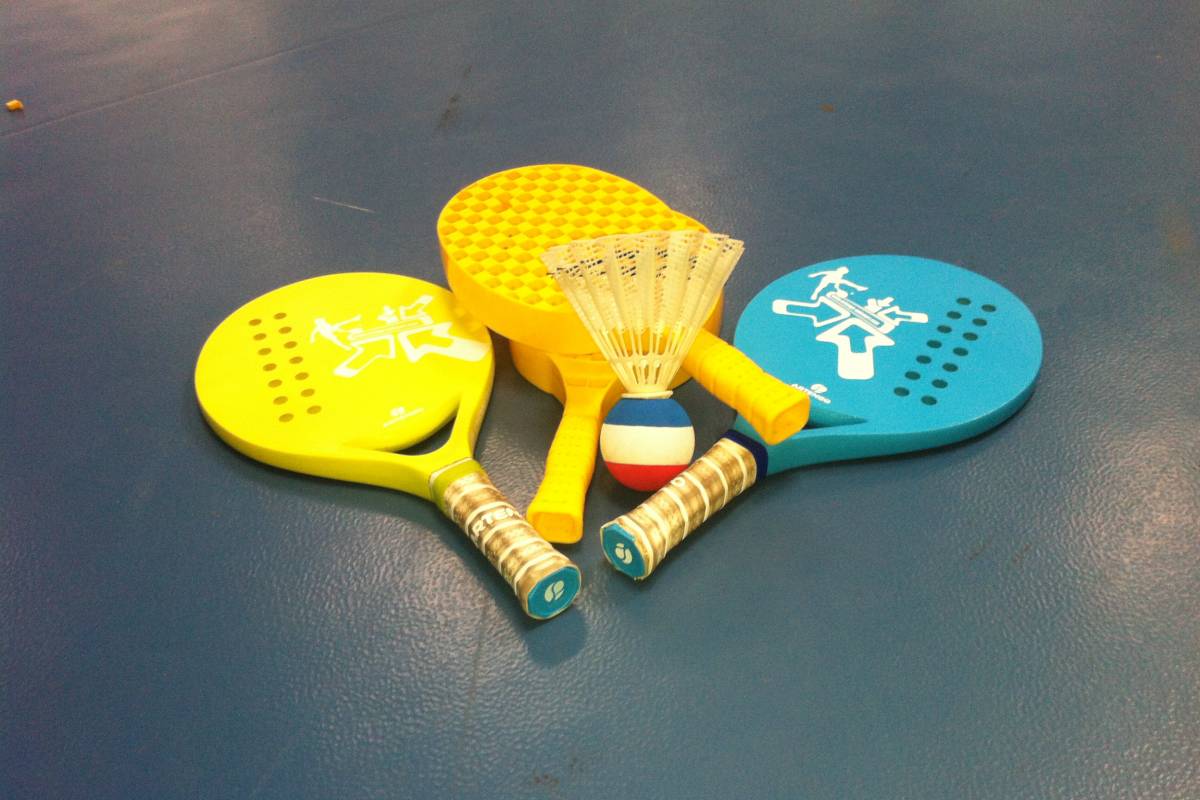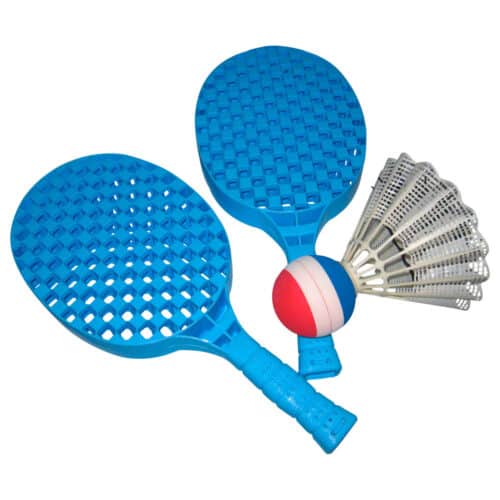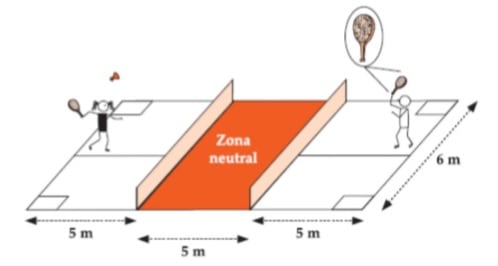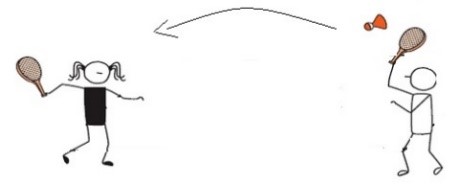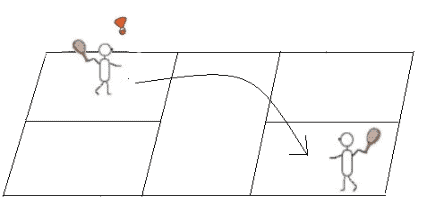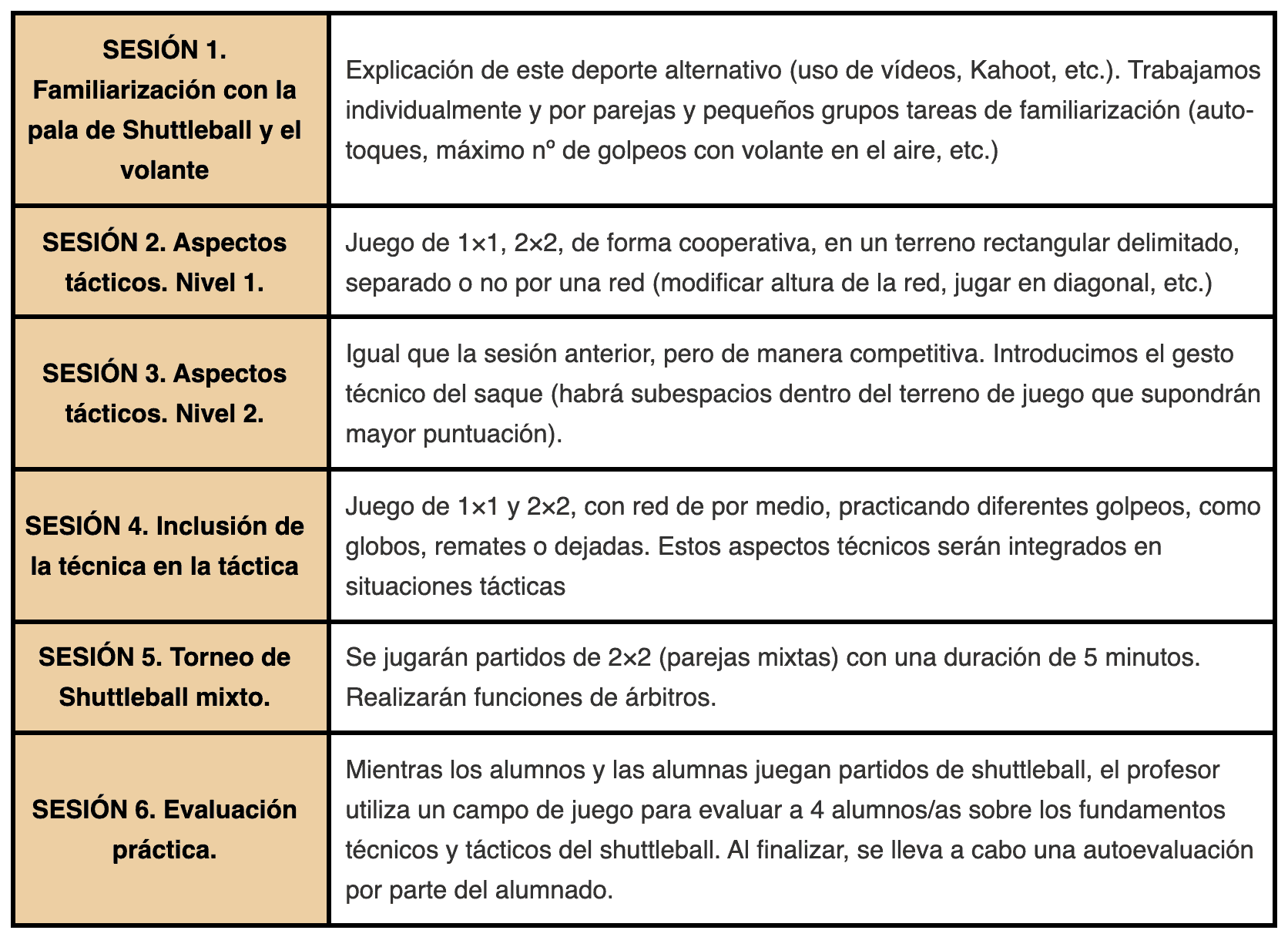This article aims to introduce Shuttleball as an alternative sport to be carried out in Physical Education classes.
Why do alternative sports arise?
By way of introduction, it should be said that alternative sports arise in our country due to the need to renew the programming of the Physical Education subject.
This idea was well received, both in the academic field and outside of it, due to the low cost of these sports for practice and the ease of adapting them to the entire population (1, 9).
In this sense, there are various adaptations and opportunities that alternative sports and games offer us.
Among them, the following can be highlighted (3, 6, 10).
- involve the maximum number of players possible.
- modify and adapt the rules based on the characteristics of the students.
- possibility of using self-constructed materials.
- promote the formation of mixed teams.
- highlight skill over other physical aspects
- avoid rough contacts
- adapt the game to any surface.
Therefore, proposing content to students that may be unknown to them and that may be to their liking is a way to increase their motivation and interest in the Physical Education subject (4).
This type of content breaks the monotony of practicing only traditional sports (such as soccer, basketball, handball, etc.), offering different possibilities to both students and teachers.
However, this does not mean that traditional sports should be sidelined or forgotten, but rather that a fusion of both should occur to promote the integral development of the students (7, 8).
Thus, although there are racket and paddle sports that are well-studied and rooted in the population (paddle tennis, tennis, and badminton), there are others less known, such as shuttleball, street racket, pickleball, bolpa, 360º ball, or spiribol, among others (4, 5). One of these alternative paddle sports, shuttleball, is what this article is about.
What is the origin of Shuttleball?
During the Middle Ages, there were different games in which implements like paddles were used to hit various shuttles. From there, badminton was born, and very recently, shuttleball, derived from badminton itself (6).
As the authors Cidoncha and Díaz (6) explain, shuttleball, which in Spanish is called “giant shuttle throw” or “giant shuttle,” is an original game from England designed to be played both indoors and outdoors (even with moderate wind).
This characteristic is one of the main reasons for its inclusion as content in Physical Education classes, as it allows for a fluid game, with a more intuitive trajectory and a slower shuttle speed than in badminton, thus allowing it to be practiced outdoors in optimal conditions.
Descubre la importancia de trabajar con deportes alternativos en Educación Física.
Veremos paso a paso, el auge en la última década de este tipo de deportes en el ámbito de la educación física, además se van a presentar dos propuestas prácticas para su desarrollo.
Materials and implements of shuttleball
The materials and implements used in shuttleball are: a giant shuttle and a paddle.
The shuttle has characteristics similar to that of badminton, but with small differences. It has larger dimensions (17 cm), its head is a circle with a 6.5 cm diameter, similar to a foam rubber ball, and it is usually in bright colors.
From the head emerges a 1 cm long nylon tail, to which 16 feathers are attached, forming a structure that, along with the head, weighs 50 grams (6).
Continuing with the description by Cidoncha and Díaz (2008), it can be said that the paddle is a single piece made of hard and rigid plastic.
Its weight is around 255 grams and it has a handle of 16 cm in length by 3 cm in diameter.
The hitting surface of the paddle is 24 cm long by 18 cm wide, with a thickness of 4 cm.
This surface has a structure composed of squares, one hollow and one filled, successively, forming what would be the stringing of a normal racket.
What is the shuttleball field like?
Shuttleball can be played on any type of field or court, as long as it is rectangular and can be divided by a center line and a net that separates the two fields.
It can also be played on a badminton court, but if played officially, the regulatory field will be used. The field has dimensions of 15 x 6 meters.
The playing areas are separated by a neutral zone 5 m wide, limited by two nets placed at a height of 80 cm in the central area.
Each playing area can be divided into two equal parts to perform the serve crosswise. In each of the four corners that form the court, there is a square with 115 cm sides, called the bonus square (6).
Shuttleball rules and modalities
Shuttleball is an alternative game that can be played in various ways, individually, in pairs (doubles), and mixed, although in the educational field it can also be done in groups.
Thus, recreational game situations can be proposed, leaving aside rules, field, points, etc. This style of play can be carried out both indoors and outdoors, and the main objective of this game mode is to hit the shuttle and try not to let it fall to the ground while passing it from one partner to another.
However, there is also a more competitive mode, where the official rules are included, as well as nets, field, points, etc. The different modalities are described below (3, 6).
Cooperative/creative mode
In this shuttleball mode, the game is played cooperatively, hitting the shuttle continuously, without letting it touch the ground during the game.
In this mode, it can be played between two or more partners, and the total touches of the group are counted. When serving, the shuttle must be hit below the waist, always with an upward trajectory.
Finally, the court may or may not be delimited, and there may or may not be a net, depending on how the students want to play.
With this mode, values such as group cohesion, self-improvement, respect for different learning rhythms, among others, are promoted.
Competitive mode without net
It is carried out in a delimited playing area, and it is recommended to use a 15 x 6 meters court for individual play, while for doubles, a slightly wider court is recommended (15 x 9 meters).
In each of the four corners that form the court, there may or may not be a 150 cm side square, called the bonus square (6).
A point is scored when the shuttle falls in the opponent’s area, or when the opponent fails to place the shuttle in the respective playing area.
The hit must always be performed with an upward trajectory, and it cannot be hit downward. The serve is performed behind the baseline of our area and always below the waist.
A game is won when a player reaches 8 points, always with a 2-point difference, that is, if both players tie at 7 points, the game continues until one of them achieves a 2-point advantage.
The match is won by the best of 3 or 5 games, as stipulated by the players at the beginning.
Competitive mode with net
The playing field used is the regulatory one, where the playing areas are divided by a 5-meter wide neutral zone, limited by two nets in the center of the court (in the context of physical education, it is more appropriate to use a net to divide two fields, as can be seen in the image below).
The service is drawn at the beginning of the match. Each player performs two consecutive serves, and then the service passes to the opponent. The first serve is performed in the right square, and the second from the square on the left.
In each service, the player has two opportunities, and if in one of them the shuttle touches the net and passes to the opposite field, the serve is repeated. Each time a game begins, the player who served at the beginning serves.
As in the previous shuttleball mode, there is also the possibility of marking bonus squares. It can be played both individually and in doubles mode.
Characteristics of Shuttleball
On the other hand, it is important to highlight some basic characteristics of shuttleball that should be taken into account in the practice of Shuttleball.
The player in possession of the service must:
- stand behind the baseline corresponding to their area (outside their playing zone).
- hit the shuttle diagonally towards the opposite area.
- position themselves with both feet on the ground at the moment of hitting.
- serve when the receiver is ready.
Faults are committed when a player:
- hits the shuttle with the body.
- hits the shuttle twice consecutively or more.
- performs two failed services.
- touches the net or the neutral zone (the latter in the case of playing in competitive mode without a net).
- it is not a fault when the shuttle touches and crosses the net as a result of a hit during the game.
Scoring method in shuttleball:
- The match is won by the best of 3, 5, or 7 games.
- A game is won when a player reaches 8 points, always with a 2-point difference. In case of a tie at 7 points, the game continues until one of the players obtains a 2-point advantage. When the game ends, the playing zones are exchanged.
- A point is scored when the shuttle falls in the opponent’s area or when the shuttle is hit and falls outside the rival area, in which case the player who hit loses a point.
- When a player makes the shuttle fall in the bonus square, they score 3 points.
Basic strokes of Shuttleball
In Shuttleball, the main strokes that can be executed are the following:
- Serve: the paddle is placed in a vertical position with respect to the ground and the handle as if shaking hands with a person with the least possible tension. When serving, the shuttle must be hit below the waist, always with an upward trajectory.
- Forehand or drive stroke: it is the most frequently used. It is performed from back to front, extending the arm at the moment of hitting (shoulder height).
- Backhand stroke: it is usually performed for defense; the executing arm crosses in front of the torso, with the arm coming from the opposite shoulder to the natural one.
- High stroke: it is used when the hit is performed above the head. The arm is fully extended above it, performing a wrist twist downward at the moment of impact.
- Low stroke: it is performed against a low shuttle, the arm is extended below the waist, performing a wrist twist upward to try to lift the shuttle.
Practical shuttleball proposal for physical education in the secondary education stage
Below is a sequence of sessions to work on Shuttleball in Physical Education for the 3rd year of ESO.
However, the pertinent modifications can be made, always perfectly adaptable to other levels of ESO, and to other stages, such as primary education.
Conclusion
In conclusion, it should be said that introducing our students to alternative sports implies an increase in motivation and interest in the Physical Education subject, as more traditional content such as soccer, basketball, and handball is somewhat set aside.
Thus, sports like shuttleball are very suitable content for developing transversal aspects and content such as coeducation, gender equality, interculturality, respect, etc. It even promotes socialization and group cohesion among students.
On the other hand, in terms of physical and psycho-social aspects, there are several benefits that shuttleball practice can bring us, such as improving hand-eye coordination and general dynamics, improving strength, increasing reaction and movement speed, increasing endurance, improving balance, improving self-esteem, among others.
Additionally, when practicing shuttleball in the educational field, there are numerous facilities, as there are various game modes (cooperative, competitive mode with and without net). It can be played individually, in pairs, and mixed, which facilitates the organization of tasks for the teacher.
Bibliographic references
- Ayala, E. (2013). Alternative sports and their importance for the professional in physical culture, sports, and recreation. Body, Culture, and Movement, 2(3-4), 99-114.
- Aznar, R. (2014). Racket sports. Recreational-sporting modalities with different implements. Barcelona: INDE.
- Bernal Ruiz, J.A. (2002). Games and sports with alternative material. Seville: Wanceulen.
- Blanca-Torres, J. C., González, A. and Puga, E. (2019). Racket sports. Didactic proposal of tennis in physical education. Trances, 11(1), 123-140.
- Castellar, C., Pradas de la Fuente, F., Quintas, A. and Rapún, M. (2016). Treatment of racket and paddle disciplines in physical education. International Journal of Collective Sports, 28, 51-61.
- Cidoncha, V. and Díaz, E. (2008). An alternative sport: shuttleball. Retrieved on 5/08/2021.
- Herrero, R., Pradas de la Fuente, F., Rapún, M., Peñarrubia, C., and Castellar, C. (2018). Analysis of the situation of racket and paddle sports in physical education in the secondary education stage in Murcia. Spanish Journal of Physical Education and Sports, 420, 59-74.
- Lara, A. J. and Cachón, J. (2010). Kinball: alternative sports in the training of the physical education teacher. A II International Congress of Didactics. Girona.
- Ortí, J. (2004). Sports animation, games, and alternative sports. Barcelona: INDE.
Sánchez-Alcaraz, B.J.; Sánchez-Pay, A.; Courel-Ibáñez, J. (2018). Introduction to alternative racket sports. Trances, 10(3), 267-280. - Piquer, M. (2020). Alternative sports in Physical Education. Retrieved on 7/08/2020.
{
“@context”: “https://schema.org/”,
“@type”: “FAQPage”,
“mainEntity”: [
{
“@type”: “Question”,
“name”: “What is shuttleball?”,
“acceptedAnswer”: {
“@type”: “Answer”,
“text”: “Shuttleball, also known as badminton, is a sport played with rackets and a shuttle. The objective of the game is to hit the shuttle over the net and make it fall in the opponent’s court.”
}
},
{
“@type”: “Question”,
“name”: “What are the basic rules of shuttleball?”,
“acceptedAnswer”: {
“@type”: “Answer”,
“text”: “Some basic rules of shuttleball include hitting the shuttle over the net, not letting it fall to the ground, not touching the net with the racket, and playing on a court divided by a net.”
}
},
{
“@type”: “Question”,
“name”:”How many players participate in a shuttleball match?”,
“acceptedAnswer”:{
“@type”:”Answer”,
“text”:”Shuttleball can be played both individually (1 player against another) and in pairs (2 players against another 2).”
}
},
{
“@type”:”Question”,
“name”:”What are the health benefits of playing shuttleball?”,
“acceptedAnswer”:{
“@type”:”Answer”,
“text”:”Playing shuttleball is an excellent form of cardiovascular exercise. It helps improve endurance, coordination, balance, and strengthens muscles.”
}
},
{
“@type”:”Question”,
“name”:”What equipment is needed to play shuttleball?”,
“acceptedAnswer”:{
“@type”:”Answer”,
“text”:”To play shuttleball, you need a net, rackets, and a shuttle. Players can also wear sports clothing and appropriate footwear.”
}
},
{
“@type”:”Question”,
“name”:”What is the difference between shuttleball and badminton?”,
“acceptedAnswer”:{
“@type”:”Answer”,
“text”:”Shuttleball and badminton are terms used interchangeably to refer to the same sport. Both names refer to the racket game with a shuttle.”
}
},
{
“@type”: “Question”,
“name”: “Where can I play shuttleball?”,
“acceptedAnswer”: {
“@type”: “Answer”,
“text”: “You can play shuttleball in parks, sports clubs, or facilities designated for this sport. You can also find public courts where you can practice this game for free.”
}
},
{
“@type”: “Question”,
“name”: “How long does a shuttleball match last?”,
“acceptedAnswer”: {
“@type”: “Answer”,
“text”: “The duration of a shuttleball match can vary depending on the level of play and the established rules. Generally, a match can last between 30 minutes to 1 hour.”
}
}
]
}
